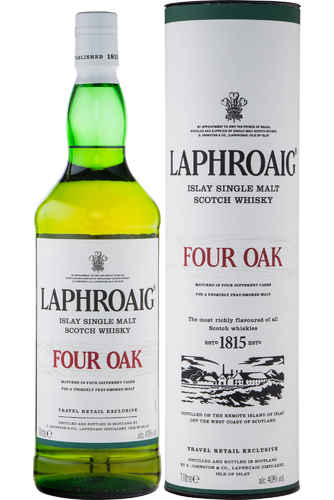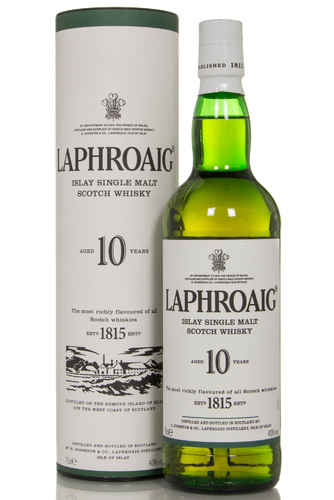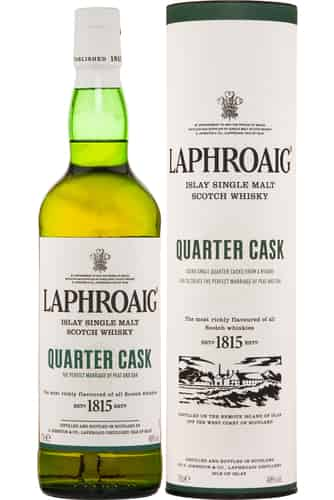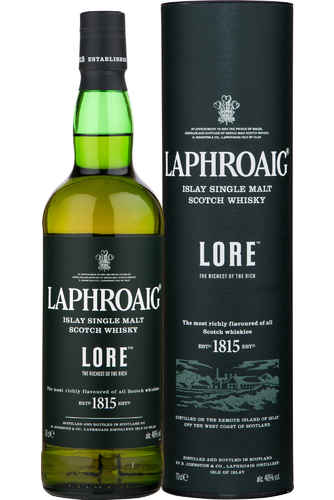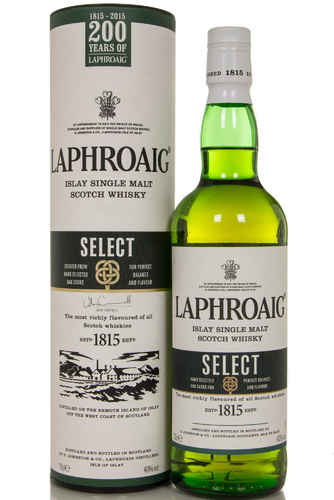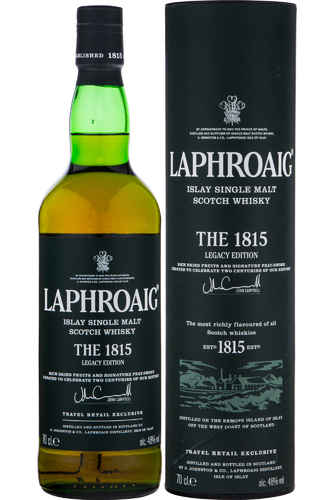 United States - DHL 15.00 € + 7.70 € /kg
United States - DHL 15.00 € + 7.70 € /kg
Laphroaig
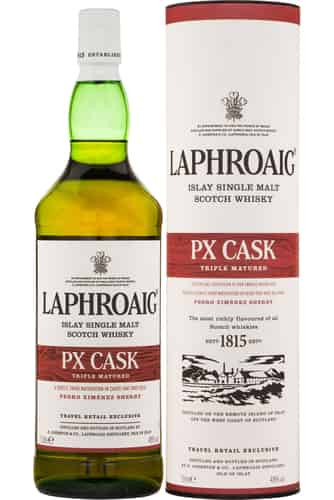
Laphroaig PX Cask Triple Matured (1 Liter)
100 cl, 48%In stock79.20 €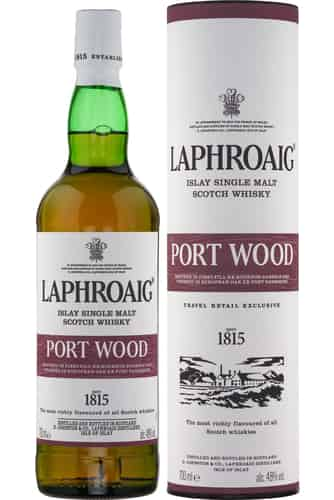
Laphroaig Port Wood
70 cl, 48%In stock119.20 €![]()
Laphroaig Four Oak (1 Liter)
100 cl, 40%In stock55.20 €![]()
Laphroaig 10 Year Old
70 cl, 40%In stock39.20 €![]()
Laphroaig 10 Year Old Cask Strength Batch 16
70 cl, 58.5%In stock92.00 €![]()
Laphroaig Quarter Cask
70 cl, 48%In stock44.00 €![]()
Laphroaig Lore
70 cl, 48%In stock100.00 €![]()
Laphroaig Select
70 cl, 40%In stock35.20 €![]()
Laphroaig The 1815 Legacy Edition
70 cl, 48%In stock92.00 €
Sorry, we didn't find anything. Please try changing your search criteria.
Laphroaig History
For some whisky drinkers, there is only one Islay distillery: Laphroaig. The distillery’s ferociously peaty, maritime and medicinal notes have made it an Islay institution. Besides the flavours, the minimalist and striking designs of their bottles are iconic, representing much about the distillery, and about the simple art of distilling itself. For over 200 years, the pleasing green and white bottles, plainly adorned with a plume of feathers (a symbol of the Prince of Wales’ personal affection for Laphroaig) have signalled a quality malt. It is undoubtedly an unusual, perhaps even an acquired, taste even for those with a penchant for peaty whiskies, but it is one with many millions of fans across the globe.
All malt whiskies begin with malted barley, and Laphroaig is unusual in that a quarter of its malt comes from in-house floor-maltings. The other three quarters is taken from the ubiquitous Port Ellen maltings, and peated to around 43 ppm. The peat the distillery uses is sourced nearby, and cut by hand. This is key to Laphroaig’s flavour profile, as the local peat contains a lot of decayed seaweed. Laphroaig is unique in its kilning process, smoking the barley first for 17 hours, before using dry air on the malt for a further 19. Even the other 5 distilleries that continue to run floor maltings tend to combine this process.
The barley type used is the industry standard Optic malt, which is then ground by a porteous mill. After this the grist is mashed in stainless steel mashtun with water from the nearby Kilbride reservoir (the water supply of Laphroaig has been the cause of much controversy! But more on that later), three times: once 67, and twice at 85 degrees centigrade. The Kilbride stream is itself rather peaty, running through nearby bogs, and contributing to the final flavour of the whisky.
After this, the wort fills 6 stainless steel washbacks, where mauri culture yeast is added. Fermentation occurs for 55 hours (shorts) or 90 hours (longs). The long fermentation here is remarkably lengthy. Fermentation occurs at about 18 degrees, and produces a beer of 8.5%.
The stills situation at Laphroaig is an interesting one. There are three wash stills, all onion shaped with a capacity of over 12,000 litres, heated by steam pans. Two of these stills have a mysterious origin, the date of their installation unknown, whilst one was first appeared the distillery in 1972. The low wine run lasts around 5 hours. Yet it is the spirit stills that attract attention: with four spirit stills, three much smaller than the other, all in the lamp glass shape.
The smaller stills have a capacity of 4,700 litres, whilst the larger one is double this size. As the beer produce is enough to fill 5 wash stills, Laphroaig does two runs, the first filling three wash stills and the three smaller spirits stills, and the second filling two wash stills and the larger spirit still. Laphroaig makes one of the latest cuts in the industry, resulting in the signature medicinal and phenolic flavours.
The vast majority of Laphroaig’s casks are ex-bourbon, from Maker’s Mark no less! The distillery has also made notable use of quarter cask barrels- beloved of Tasmanian and Australian distillers. Laphroaig also matures some spirit in ex-sherry and port casks. The distillery has 8 warehouses on Islay, in both dunnage and racked style. They also mature some spirit on the Scottish mainland (as is the industry standard), however, this is mainly used in blends. The vast majority of whisky that is bottled as Single Malt is matured at home in Islay.
The history of Laphroaig spans over 200 years, and it has been a remarkable stalwart of the scotch whisky industry. Founded in 1815, though suggested that it was built sometime before this, around 1810, when the Johnston family first started farming the land. The extended Johnston family controlled Laphroaig for much of its history. After founding the distillery, Alex and Donald Johnston ran the distillery together, until 1836, when Alex withdrew.
Donald would continue to manage the Laphroaig until his death. Donald (genuinely) came to a sticky end, dying after falling in a washback. After this tragic event, the distillery was leased to Lagavulin for 9 years, until 1856. The Johnston family then took over again, operating the distillery under the name "Dugald Johnston & Co." this arrangement continued well into the 20th century.
During its history, Laphroaig has seen many run-ins with its equally illustrious neighbour, Lagavulin. The most notable clash occurred in the first decade of the new century. For many years, Laphroaig whisky had been sold by Lagavulin, with the latter distillery acting almost as "brand ambassadors" for the former.
Yet in 1907, Laphroaig decided that they could now sell their own whisky, cutting out the middle man and broke off the contract. Once the courts allowed them to do so, the enraged Mackie knocked up a dam, and blocked off the distillery’s water supply. Again, Lagavulin and Laphroaig found themselves in court, and again, the courts ruled in favour of Laphroaig. Water flowed again to the distillery.
In 1923, the distillery expanded, and added another two stills, bringing the total to four. During the Second World War, the distillery was taken over as a military depot. Ian Hunter, a member of the extended Johnston family then bequeathed Laphroaig to Bessie Williamson (his then secretary) upon his death in 1954. Bessie was the first female distillery manager on Islay, and possibly in Scotland.
Bessie Williamson remains one of Scotch whisky’s historic "characters". During her reign Laphroaig strengthened its links with the island, having annual peat cutting days (in which Bessie actively participated), and hosting weekly Gaelic dances (known as Ceilidhs). She also oversaw an expansion to 6 stills. The distillery was purchased from Bessie between ’62 and ’67 by Long John Distillers, though she remained in charge until her retirement in 1972.
In 1974, Laphroaig was expanded again, with the large spirit still being installed. This brought the total number of stills to 7. In just over 50 years, the distillery had added another 5 stills, one for every decade! The next year Long John Distillers was acquired by Whitbread & Co. Ltd, before selling Laphroaig to Allied Distillers in 1999. They owned it until 2005, when the present owners, Fortune Brands, took over.

